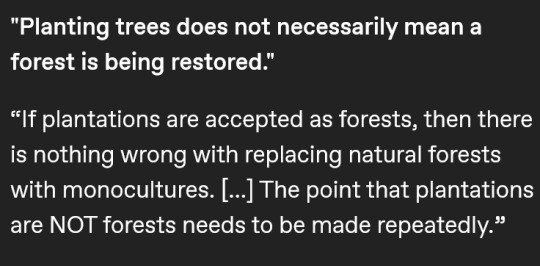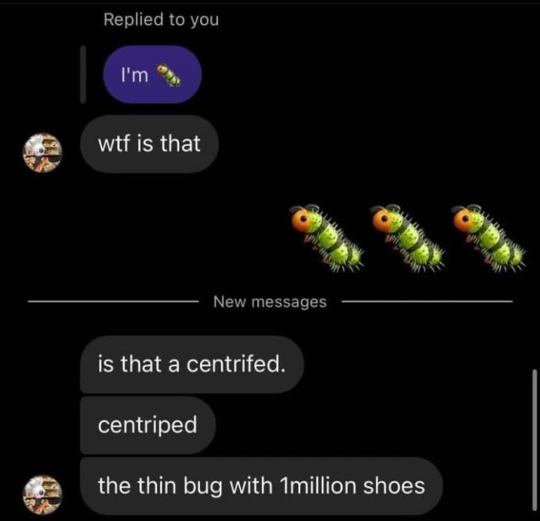fake cannibalism fans dni. 18+. no terfs no zios. 𖦹 art blog: spiralpilled.tumblr.com
Don't wanna be here? Send us removal request.
Text
moving day todayyyyyyy goodbye to homelessness and #MOLD YAY YAY YAY
4 notes
·
View notes
Text

— Ursula K. Le Guin, from “A Rant About ‘Technology’”
65K notes
·
View notes
Text
humans are shockingly intelligent creatures but unfortunately human meatballs are good as fuck soooo :/
7K notes
·
View notes
Photo






December 21 2015 - Croatians and Slovenians protested at the border between the two countries in response to the border being reinforced to stop immigrants. [video]
2K notes
·
View notes
Text

14K notes
·
View notes
Text
maybe should go on my nsfw but people who say they have breeding kinks but arent into any aspect of pregnancy or even impregnation are so annoying like thats called a creampie #mytruth
11 notes
·
View notes
Text

my very first seitan "ham" and actually my very first seitan anything. its giving shane dawson guys im kind of getting better but smells really good (i topped it with a spicy mustard & syrup sauce)... i hope the texture is good too we will see tmrw
#surprisingly easy to make !! takes some time but most of it is passive and its just in the oven#kinda like baking bread but more complicated#diary#𖦹
4 notes
·
View notes
Text
you should really be able to annotate your blocklist on here it's untenable having it all mixed up like this. how am i supposed to know if i blocked this person for writing a smiley emoticon on a day when i was feeling particularly bitter or if it was for reblogging from transmisogynists like i needdd a zotero notes function for this. ik someone already said this but i can't find the post probably because i blocked op for i don't know what reason. because my blocklist isn't annotated
5K notes
·
View notes
Text
Help my family🩸
I am nedaa from the Gaza Strip. In the beginning, we lived for a short time in our house in temporary stability because our country was not a country of stability in the first place due to the ongoing wars on the Strip. My husband had a job and he had a source of income sufficient for us initially. On the seventh day of October, and on this morning, we woke up to... The beginning of this bloody war, shortly after the bombs fell on us and the disappearance of our basic needs of food, water, the necessities of life, pampers and milk, and after the bombing that hit the homes next to us, and after that we were forced to leave the house due to a ground operation and an order to evacuate the homes and the advance of tanks and shooting at us. We went out and my children and I could not. My husband and I wanted to take the most basic needs of blankets, mattresses, clothes, and food due to the lack of transportation during those difficult days. This was in the month of January, when it was winter and bitter cold. We walked long distances and were stranded until after that we were able to reach and flee to the city of Rafah, which was sparsely populated and almost Deprived of life, we were displaced to a place made up of tin, where deadly insects and germs were eating the bodies of our children. There was no water, no food, and nothing of the necessities of life. We struggled to get some food and water, and after a while, due to the severe bombing next to us, we were forced to flee again to the Khan Yunis suburbs. We were displaced inside the Khan Yunis suburbs for more than Once, due to violent bombing and shooting over our heads, we lived in tents made of cloth and wood, and my children lived through difficult days of fear and anxiety due to the intensity of the bombing. We learned during those days that our small house, which we had originally carved out of my father’s house, had been largely destroyed due to the violent bombing, and after several months. Living in tents, high heat, and the bitter cold of winter led to the withdrawal of vehicles from the areas in which we live, and we were able to reach our homes, which we were shocked by at the scene we saw of the horror of destruction caused by that war. We were forced to return to our destroyed home and set up shields to protect us from the elements of nature, and there was nothing there. Among the necessities of life, there is no food or water. The infrastructure was and still is completely destroyed, with sewage in the streets and we cannot bring water except with great difficulty. Now we are exposed to the cold and harsh winter and we need scarves and nylon to cover ourselves from the winter water. Even now we are exposed to shelling, bombs and gunfire. What is the fault of my children, Aysel? And Nidal, they live in this disastrous situation that does not provide them with the simplest basics of life, such as Pampers, milk, and all the necessities of life, and now we are living in a war of exorbitant prices in which we cannot provide the money to buy these needs, and now I am speaking to you, I and my small family are forced to ask for help from you so that we can secure a future. For my children, as we travel outside this country because of the constant wars, do not let us down and do not deprive us of your kindness and generosity.
Nedaa of Abd al-Rahman Nidal Aysel from the Gaza Strip
Thank you all



19K notes
·
View notes
Text
cumming in your underwear for no reason is gonna be huge in 2025 you can quote me on that #trends
18K notes
·
View notes
Text

Despite its green image, Ireland has surprisingly little forest. [...] [M]ore than 80% of the island of Ireland was [once] covered in trees. [...] [O]f that 11% of the Republic of Ireland that is [now] forested, the vast majority (9% of the country) is planted with [non-native] spruces like the Sitka spruce [in commercial plantations], a fast growing conifer originally from Alaska which can be harvested after just 15 years. Just 2% of Ireland is covered with native broadleaf trees.
Text by: Martha O’Hagan Luff. “Ireland has lost almost all of its native forests - here’s how to bring them back.” The Conversation. 24 February 2023. [Emphasis added.]
---
[I]ndustrial [...] oil palm plantations [...] have proliferated in tropical regions in many parts of the world, often built at the expense of mangrove and humid forest lands, with the aim to transform them from 'worthless swamp' to agro-industrial complexes [...]. Another clear case [...] comes from the southernmost area in the Colombian Pacific [...]. Here, since the early 1980s, the forest has been destroyed and communities displaced to give way to oil palm plantations. Inexistent in the 1970s, by the mid-1990s they had expanded to over 30,000 hectares. The monotony of the plantation - row after row of palm as far as you can see, a green desert of sorts - replaced the diverse, heterogenous and entangled world of forest and communities.
Text by: Arturo Escobar. "Thinking-Feeling with the Earth: Territorial Struggles and the Ontological Dimension of the Epistemologies of the South." Revista de Antropologia Iberoamericana Volume 11 Issue 1. 2016. [Emphasis added.]
---
But efforts to increase global tree cover to limit climate change have skewed towards erecting plantations of fast-growing trees [...] [because] planting trees can demonstrate results a lot quicker than natural forest restoration. [...] [But] ill-advised tree planting can unleash invasive species [...]. [In India] [t]o maximize how much timber these forests yielded, British foresters planted pines from Europe and North America in extensive plantations in the Himalayan region [...] and introduced acacia trees from Australia [...]. One of these species, wattle (Acacia mearnsii) [...] was planted in [...] the Western Ghats. This area is what scientists all a biodiversity hotspot – a globally rare ecosystem replete with species. Wattle has since become invasive and taken over much of the region’s mountainous grasslands. Similarly, pine has spread over much of the Himalayas and displaced native oak trees while teak has replaced sal, a native hardwood, in central India. Both oak and sal are valued for [...] fertiliser, medicine and oil. Their loss [...] impoverished many [local and Indigenous people]. [...]
India’s national forest policy [...] aims for trees on 33% of the country’s area. Schemes under this policy include plantations consisting of a single species such as eucalyptus or bamboo which grow fast and can increase tree cover quickly, demonstrating success according to this dubious measure. Sometimes these trees are planted in grasslands and other ecosystems where tree cover is naturally low. [...] The success of forest restoration efforts cannot be measured by tree cover alone. The Indian government’s definition of “forest” still encompasses plantations of a single tree species, orchards and even bamboo, which actually belongs to the grass family. This means that biennial forest surveys cannot quantify how much natural forest has been restored, or convey the consequences of displacing native trees with competitive plantation species or identify if these exotic trees have invaded natural grasslands which have then been falsely recorded as restored forests. [...] Planting trees does not necessarily mean a forest is being restored. And reviving ecosystems in which trees are scarce is important too.
Text by: Dhanapal Govindarajulu. "India was a tree planting laboratory for 200 years - here are the results." The Conversation. 10 August 2023. [Emphasis added.]
---
Nations and companies are competing to appropriate the last piece of available “untapped” forest that can provide the most amount of “environmental services.” [...] When British Empire forestry was first established as a disciplinary practice in India, [...] it proscribed private interests and initiated a new system of forest management based on a logic of utilitarian [extraction] [...]. Rather than the actual survival of plants or animals, the goal of this forestry was focused on preventing the exhaustion of resource extraction. [...]
Text by: Daniel Fernandez and Alon Schwabe. "The Offsetted." e-flux Architecture (Positions). November 2013. [Emphasis added.]
---
At first glance, the statistics tell a hopeful story: Chile’s forests are expanding. […] On the ground, however, a different scene plays out: monocultures have replaced diverse natural forests [...]. At the crux of these [...] narratives is the definition of a single word: “forest.” [...] Pinochet’s wave of [...] [laws] included Forest Ordinance 701, passed in 1974, which subsidized the expansion of tree plantations [...] and gave the National Forestry Corporation control of Mapuche lands. This law set in motion an enormous expansion in fiber-farms, which are vast expanses of monoculture plantations Pinus radiata and Eucalyptus species grown for paper manufacturing and timber. [T]hese new plantations replaced native forests […]. According to a recent study in Landscape and Urban Planning, timber plantations expanded by a factor of ten from 1975 to 2007, and now occupy 43 percent of the South-central Chilean landscape. [...] While the confusion surrounding the definition of “forest” may appear to be an issue of semantics, Dr. Francis Putz [...] warns otherwise in a recent review published in Biotropica. […] Monoculture plantations are optimized for a single product, whereas native forests offer [...] water regulation, hosting biodiversity, and building soil fertility. [...][A]ccording to Putz, the distinction between plantations and native forests needs to be made clear. “[...] [A]nd the point that plantations are NOT forests needs to be made repeatedly [...]."
Text by: Julian Moll-Rocek. “When forests aren’t really forests: the high cost of Chile’s tree plantations.” Mongabay. 18 August 2014. [Emphasis added.]
2K notes
·
View notes
Text
bored of puppyboys and catboys. lets consider the humble fishboy, who you can stick hooks in and also gut with a knife. and he loves it
20K notes
·
View notes
Text

これは猫ハラでいいよね
I think it can be said the cat harassment...
4K notes
·
View notes
Text
time to waste the last month of 2013 on the internet
302K notes
·
View notes


